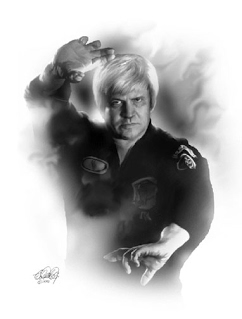To understand karate techniques and how they function, you must have knowledge of physics. You must study the body and learn how the senses — through the principles of mass, speed, body alignment, angles, momentum, gravitational marriage, torque, focus, stability, power and penetration — can make the body function intuitively. An in-depth study of these principles of physics will also reveal the sophistication contained within basic techniques.

“He who hesitates, meditates in a horizontal position” is a statement I use to imply the need for prompt action. It is a statement referring to speed. “Do it now,” “I want it done this instant,” “You’d better be fast,” and “Be quick about it” are all phrases that imply speed or are intended to hasten velocity regardless of direction.
As we study these terms, we learn that they are concepts related to distance and time. By definition, speed equals the distance divided by the time it takes to move there.
Speed, however, goes beyond this definition. Like the Eskimo who uses a number of terms to describe types of snow, we too must distinguish and categorize speed to make it meaningful to the karate enthusiast.
There are three categories of speed: perceptual, mental and physical. However, while the categories are separated in order to analyze what speed entails, they function as one.
Perceptual Speed
Perceptual speed is the quickness of the senses in monitoring the stimulus they receive, determining the meaning of the stimulus and conveying the information to the brain so that mental speed can arrange the proper response.
To the karate practitioner, it is the feel or smell of trouble; a sound, sign or gesture that suggests trouble; the sight of an incoming strike; or the opportunity to attack or counterattack.
Speed of this type can be increased by maintaining alertness and by conditioning the senses to develop environmental awareness.
Mental Speed
Mental speed is the quickness of the mind to select appropriate movements to effectively deal with an incoming stimulus. Speed of this type can be increased only by practicing various karate techniques on a regular basis.
This involves learning the techniques to a point of total familiarity and instinctive response.
As you broaden your knowledge of combat alternatives and learn how to tap into the movements and concepts stored in your consciousness, the speed of your instinctive response increases.
Physical Speed
Physical speed is the quickness of physical movement — fluency in response to a stimulus, and the speed with which one executes a technique. Speed of this type can be increased through stretching, body conditioning and other methods of training.
Stretching exercises help increase elasticity, which automatically develops reach. Body conditioning prevents fatigue and allows a high level of speed to be maintained for longer periods of time.
Economy of Motion
Knowledge of the principle of economy of motion also contributes to speed. It helps you avoid erroneous angles and teaches you how to administer your strength.
This principle stresses the importance of being relaxed when striking, tensing only at the moment of impact; making one aware that time is crucial; using movements that follow direct angles and paths; eliminating “telegraphing” of techniques unless as a means of deceptive strategy; using continuity, flow and rhythm; responding to combat from natural postures; learning about target accessibility; and distance, or range.
In conclusion, while speed often enhances power, it is not the root of power. Synchronization of body mass and speed is the major ingredient that creates power.
Story by the late Ed Parker
![]()
